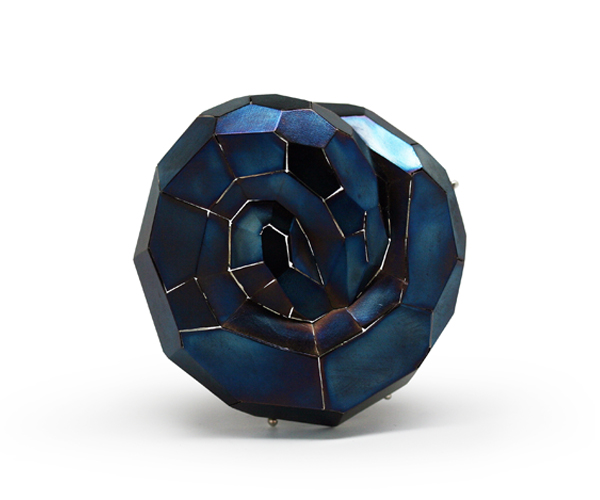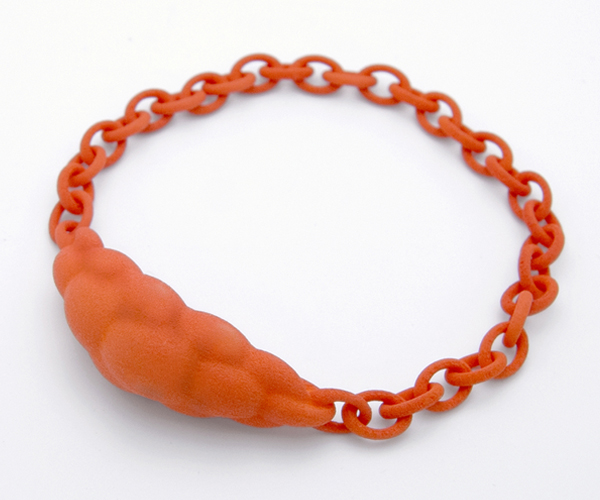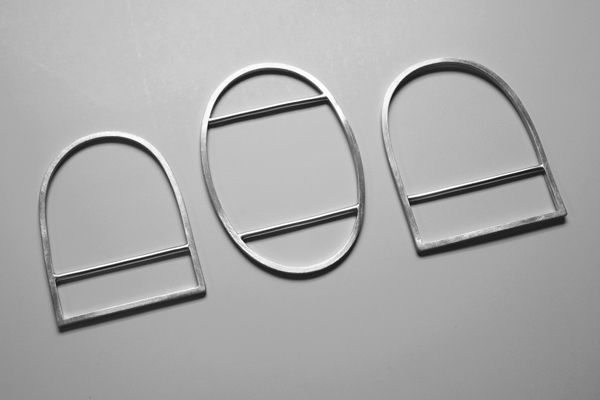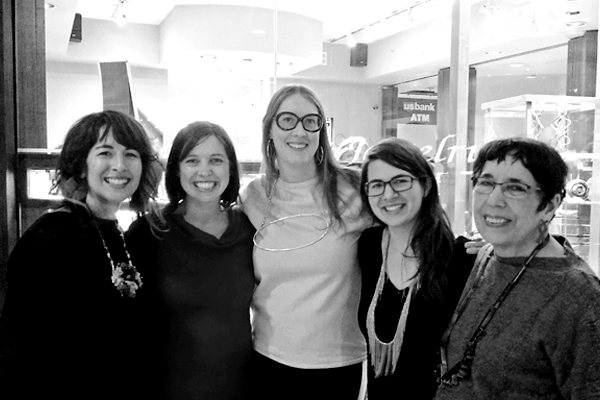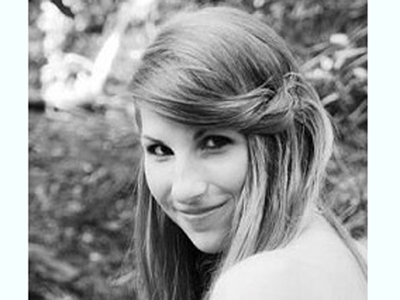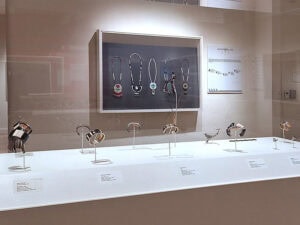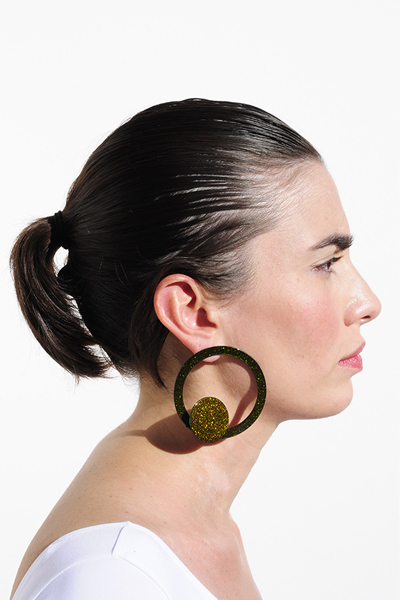 In this interview, curator Madeline Courtney discusses her concept for the exhibition Outer Limits, which was recently presented at Facèré Jewelry Art Gallery in Seattle, Washington. Outer Limits showcased work by Jana Brevick, David Choi, Rebecca Hannon, Arthur Hash, Shayna Illingworth, Tia Kramer, emiko oye, Rachelle Thiewes, and Myung Urso.
In this interview, curator Madeline Courtney discusses her concept for the exhibition Outer Limits, which was recently presented at Facèré Jewelry Art Gallery in Seattle, Washington. Outer Limits showcased work by Jana Brevick, David Choi, Rebecca Hannon, Arthur Hash, Shayna Illingworth, Tia Kramer, emiko oye, Rachelle Thiewes, and Myung Urso.
Missy Graff: Outer Limits usually refers to outer space, and there was a TV show with this name in the 1960s. There was also a jewelry show called Out of This World! Jewelry in the Space Age, which dealt with outer space. Is that what this title refers to?
Madeline Courtney: This title does refer loosely to the 1960s television show Outer Limits. The first lines of each episode are: There is nothing wrong with your television set. Do not attempt to adjust the picture. We are controlling transmission. If we wish to make it louder, we will bring up the volume. If we wish to make it softer, we will tune it to a whisper. We will control the horizontal. We will control the vertical. We can roll the image, make it flutter. We can change the focus to a soft blur or sharpen it to crystal clarity. For the next hour, sit quietly and we will control all that you see and hear. We repeat: there is nothing wrong with your television set. You are about to participate in a great adventure. You are about to experience the awe and mystery which reaches from the inner mind to—The Outer Limits.
“Mid-century modernism” has returned as a term now associated with current trends in art and architecture. In many ways, the Outer Limits exhibition recaptures the bold and futuristic inventiveness of the 1960s. Jewelry art is at an especially playful junction of art and design. It is worn on the outer limits of the body and allowed to move with the wearer. For instance, Rachelle Thiewe’s work literally orbits the body. The chameleon and color-shifting auto-body paints that adorn her earrings and bracelets offer a kaleidoscope of color as the wearer moves.
What criteria did you use in the selection process? What are the common elements between the works of these artists?
Madeline Courtney: The vision for Outer Limits was a show that would be fantastical and playful, as well as avant-garde. I looked for work that pushed art, design, and fashion; that was orbital, extreme, and had limited boundaries; work that felt futuristic and out of this world.
What all of these artists have in common is an experimental approach to material, space, and technology. While an embrace of modern materials, such as plastics and laminate, as well as computer-aided approaches, define much of this work, Myung Urso’s handmade and painterly aesthetic serves as an interesting counterpoint. Her work represents a complete disregard of technology, a return to materialism and craft. The tangible materiality and spontaneity in her work can in some ways be viewed as a response to the systematized monotony of a machine-based world, or a playful look at what jewelry might be in a pre- or post-technological world.
What kinds of materials represent the “outer limits” of contemporary jewelry? What kind of techniques?
Madeline Courtney: References to technology and industry are found in much of the work. This approach creates many interesting hybrids vis-a-vis material and technique. David Choi, for example, combines CAD design with a handmade approach to create his origami-like structures. Arthur Hash employs the technical genius of 3D printing. Tia Kramer, with the lightest touch, makes handmade paper glow. And emiko oye restructures LEGO® from toy to art.
Since this exhibition is about each artist pushing those boundaries, can you please point out a few of your favorite examples and discuss them?
Madeline Courtney: In her Killing Moon Series, emiko oye has reinterpreted glittery fashion photography and precious jewelry in a series of pixilated, surrealist lips that are still true to her LEGO® love. Rebecca Hannon transforms laminate into bold color and geometric shapes that become architecture for the body. Jana Brevick takes her work of the past decade and distills it into stark, strong, wearable sculpture. Shayna Illingworth reenvisions Victorian day-to-night earrings through a space-age sensibility, combining delicate beadwork with unusual stones and removable parts.
Since your gallery is located in a retail shopping area, I assume you get a lot of visitors who are not familiar with art jewelry. How do you help educate the general public about it?
Madeline Courtney: Our staff knows that our gallery is our “living room,” and we make a point of engaging with everyone who enters Facèré. We love what we do, and in sharing about our artists and their work, this enthusiasm comes across to our visitors.
Being in a retail setting makes us more accessible to the public. The glass walls of the gallery, our intimate size, and multiple entrances—the building itself—add to the openness and accessibility of the space.
We encourage as much wearing and touching of the jewelry as possible. Jewelry art has multiple contexts in which it can be appreciated, but ultimately, it is understood through how it relates to the body. Our goal is to capture the hearts and imaginations of our customers by encouraging them to explore what jewelry art and adornment can mean to them.
Conversation and sharing are key. One time a young boy asked me why David LaPlantz’s brooches were “not of anything,” most likely referring to their abstract nature. After I shared a little about the appeal of shapes, colors, and contrasts, the boy had an “aha” moment and said, “Oh! It’s like architecture for the body!” I couldn’t have said it better myself!
Many of our readers are emerging artists. Do you have any advice for jewelers who are new to the field? In your opinion, what is the best or worst way to approach a gallery?
Madeline Courtney:
• When you visit a gallery, introduce yourself as a jeweler.
• Wear your jewelry art. Everywhere. Everyday.
• Have cards available and hand them out generously.
• Promote and maintain an easy-to-use website.
• Document and sign your work.
We know that you like to read, so have you read anything lately that you would like to recommend?
Madeline Courtney: Madeline Albright’s collection is coming to Bellevue Arts Museum (a bridge away). I’m rereading her book, Read My Pins. It’s even better the second time around!


